This is my favorite pierogi dough recipe – soft, elastic, smells of butter and is easy to roll out. This is the best pierogi dough recipe you’ll find. Below I’m also sharing many tips on how to make the perfect pierogi and answer all the questions you could have.
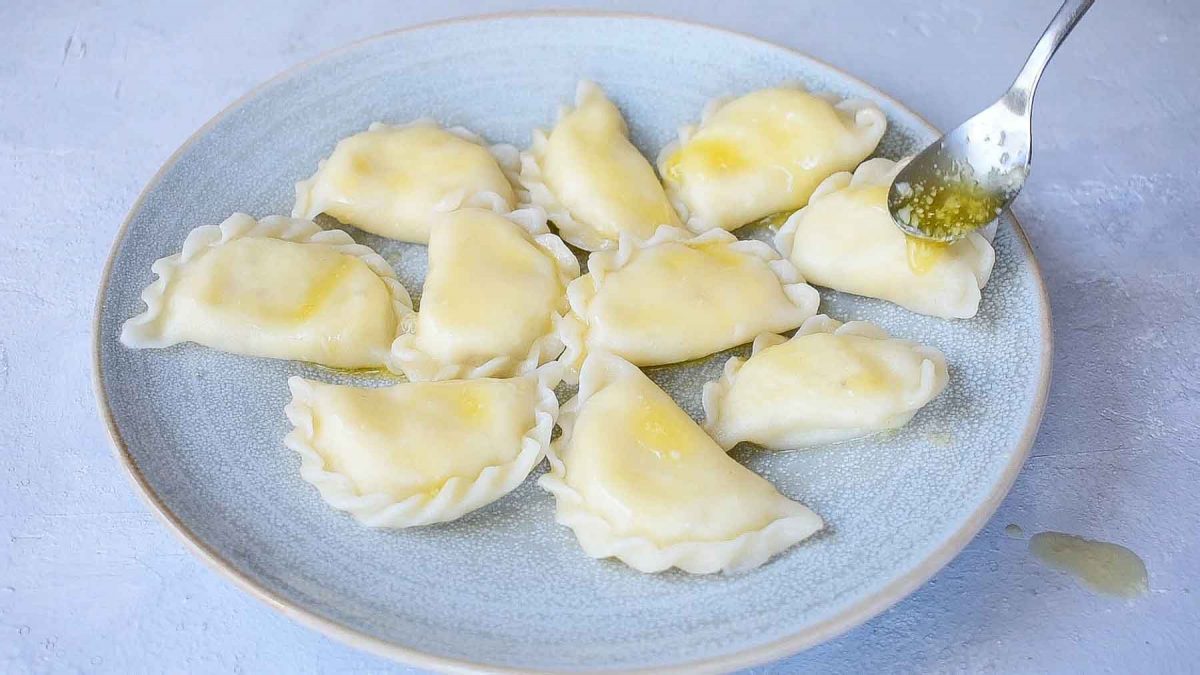
What are pierogi/pierogies?
Pierogi are Polish dumplings, made with unleavened dough and filled with sweet or savory fillings. They are boiled and then sometimes additionally pan-fried.
Pierogi in Poland:
Pierogi are one of the most popular Polish dishes. They are served as a main dish or as a side dish. The most popular pierogi are potato and cheese pierogi, sauerkraut and mushroom pierogi, and pierogi with meat filling (at least in the region where I’m coming from). In summer sweet pierogi (filled with fruits, like strawberries and blueberries) are popular. The flavor combinations are countless.
In Poland you can find small restaurants, where only pierogi are being served, they are filled with many different fillings. Such a restaurant is called ‘pierogarnia’.
Pierogi, Pierogies or Perogies?
Although the word ‘pierogies’ is popularized in English-speaking countries, it is not the true name of these Polish dumplings. The correct name is: singular – 1 pieróg and plural – pierogi. There are no other terms to name it.
What is the difference between pierogi and ravioli:
Ravioli are Italian dumplings, that are wrapped in pasta dough (this dough must contain eggs and is more rich and tough). Italian fillings also differ from traditional pierogi fillings.
Top tips for making the perfect pierogi dough:
- Traditional pierogi dough is easy to make without a recipe (I think no Polish grandmother makes it with a recipe, at least both my grandmothers don’t). The exact recipe is not important here, if the dough is too dry, you need to add some water, if too wet – a little bit of flour. However, it is worth having your favorite recipe and a kitchen scale on hand – the preparation goes much faster, the ingredients are added into a bowl and kneaded together, you don’t need to add additional water or flour.
- One of the most important things is, that the dough is well-kneaded!
- After kneading the dough, let it rest. You can see on my video how much softer and pliable the dough is after it has rested.
- Best water temperature – very hot but not boiling.
- Add some fat – it can be butter (more flavor) or oil.
- Don’t add eggs to the dough (more on that below).
- Dough to filling ratio: it’s very important, but it’s also a matter of taste. I like it when my dough is not very thin but also not very thick. I like to stuff my pierogi with lots of filling but I also like to taste the dough. Experiment what works best for you.
Easy pierogi dough ingredients:
- The best flour to make pierogi – I’m using all-purpose flour.
- Water – it’s important to add hot water to the dough. It makes the dough soft and pliable. You should warm the water with butter until they are very hot, but not boiling (temperature around 80-90 °C / 176-194 °F, that is when the water starts to move and steam). Too hot water will make the dough a little bit more chewy and sticky. Cold water will make the dough harder to roll out and it will be more difficult to shape the pierogi.
- Fat – you could make the dough without it, but it really makes the dough perfect. I’m using butter for its taste but any vegetable oil will also work.
- Salt – also the dough should be seasoned, not only the filling.
- I’ve seen some recipes that call for sour cream. Personally, I’ve never heard of such pierogi dough ingredient and don’t know anyone who is making pierogi with it (at least in Poland). I think it’s more an American or Russian/Ukrainian ingredient. Nowadays though, many home cooks experiment with the ingredients. Authentic Polish pierogi dough recipe call just for flour, water, salt, and optionally some fat and an egg.
Pierogi dough with egg or no egg:
There are two ways of making the pierogi dough – with or without an egg. Many Polish home cooks are arguing, which way is the best.
For me, the perfect pierogi dough is made without the egg. The dough with eggs is a bit tougher in my opinion, but the difference with a well-kneaded dough is not that huge (but there is a difference).
The second reason why I don’t add an egg is that it’s more hygienic – having a small child at home, I usually make a lot of pierogi in one batch, but making a lot of breaks in between. I do not have to worry about washing my hands thoroughly all the time, taking care if the table is well cleaned and watching out if my daughter is eating a dough with a raw egg.
By the way, you should try making pierogi with your kids. Rolling out the dough, cutting out rounds, shaping the pierogi – I think it’s a fascinating activity for every child!
Since this pierogi dough is made without eggs it is suitable for vegetarian diet, vegan diet or dairy-free diet (swap the butter for vegetable oil), or egg-free diet.
What equipment do you need:
- I love making my pierogi dough in my Kitchen Aid but you can also make it by hand. You’ll need to knead the dough for about 10 mins. A food processor can also be used (fitted with the dough blade), but I prefer the stand mixer.
- A rolling pin (or alternatively a wine bottle!). For rolling out the dough you can use a pasta maker (I’m sometimes using my Kitchen Aid pasta attachment). I find that it’s equally easy to roll out the dough by hand and with the pasta maker. Pierogi dough is much more pliable and soft in comparison to pasta dough, which makes it easier to roll out by hand.
- Pierogi cutter / pastry cutter / a cup (preferably with sharp edges). I prefer to use a real pierogi cutter or a pastry cutter – it’s easier to cut out rounds. A regular glass/cup can also be used but I find cutting out round a little bit harder as its edges are more thick and blunt. It would be better to use a glass that has thin, sharp edges if you don’t have a pierogi cutter (both my grandmas are using a regular glass though ;)).
- A pot to cook the pierogi (obviously) and a slotted spoon.
- There are pierogi maker press or pierogi molds available if you search online. I haven’t personally tried them out. Feel free to let me know if there are any that you really like!
How to make pierogi dough – step by step:
STEP 1: Add flour and salt to a large bowl.
STEP 2: Add hot water with butter.
STEP 3: Mix with a wooden spoon until roughly combined.
STEP 4: Knead the dough until smooth and soft.
STEP 5: Prepare the filling.
STEP 6: Roll out the dough and cut out the rounds.
STEP 7: Place the filling on the round.
STEP 8: Shape the pierogi. Ready to be cooked!
How to measure the flour:
In the recipe card below, I provided all possible measurements for the pierogi dough – by volume and by weight. I’m always using a kitchen scale to make my pierogi (and generally to develop the recipes on my website). If you’re weighing your ingredients on a scale your results will be very consistent and the same as mine. It’s really easier, quicker and a kitchen scale is super cheap!
If you’re measuring the flour with measuring cups there is a possibility that you will add more or less flour than I did. You need to check the consistency of the dough and add more flour if it’s too wet and more water if it’s too dry and too tough.
Measuring the flour with measuring cups is unfortunately very inaccurate. 1 US cup of flour can weigh from 120g-140g, depending on how you fill the cup. 20g is a little over 2 tablespoons of flour, so when this recipe calls for 4 cups of flour, you could have added 8 tablespoons more flour which is 1/2 cup! For measuring flour I’m spooning the flour into the measuring cup with a tablespoon and not scooping it with the cup. Level the flour with the back of the knife and don’t tap the cup or press down the flour. Read this article for more information on how to measure flour.
1 US cup is 240 ml. An European cup is 250 ml!
How to roll out the dough with a pasta maker:
Pierogi dough can also be rolled out using a pasta machine. I have a Kitchen Aid pasta roller attachment. I roll out the dough on setting 4. According to the manufacturer’s instructions you need to roll out the dough on each setting until you get to the setting 4. I’m not doing this, pierogi dough without an egg is easier to roll out than an egg dough or pasta dough. To make it possible, the dough must be well sprinkled with flour, at room temperature, slightly rolled out with a rolling pin (to a thickness of approx. ¾ cm / ½ inch) and smooth (otherwise will tear).
How to store pierogi:
To ensure that the cooked pierogi don‘t stick to each other, brush them lightly with melted butter or oil. Store in a tightly-closed container in the fridge for about 2 days. On the next day, it‘s best to pan-fry them with butter until golden.
Freshly cooked pierogi taste best for me, so I usually do this: I prepare only the amount of dumplings that we are going to eat on a given day (about 14 per person, my pierogi are rather small, see the video for the reference). I wrap the rest of the dough tightly in plastic foil and put it in the fridge. I place the rest of the filling (or make filling balls from all of the filling) and also tightly wrap in plastic foil and put in the fridge. On the next day (or even on the third day) I’m preparing the rest of the pierogi.
If I have more time and I’m making more pierogi in one batch, I freeze them or pan-fry with butter the next day.
After removing the dough from the fridge, it is good to slightly warm it up (leave it for about 15-30 minutes on the counter), it will be more elastic (this is optional). The next day the dough can look a little gray in color, but we don‘t mind that.
Freezing tips:
- Cooked pierogi: Place the pierogi apart on a tray, sprinkled well with flour. Freeze until solid. Transfer to containers on plastic bags. Cook like fresh pierogi but take them out once they float on the water surface.
- Uncooked pierogi: Note that not boiled raw pierogi are more likely to crack in a freezer than cooked pierogi. I most often freeze raw pierogi though. Place the pierogi on a tray / wooden board sprinkled well with flour (important, dumplings can easily stick to the tray and tear). Arrange the dumplings so that they do not touch each other. When frozen, transfer them into containers or plastic bags. I cook frozen dumplings just like fresh ones, with the difference that you can cook a smaller amount of them at a time, I cook max. 7-8 frozen pierogi at once (and about 10-12 fresh). When you drop too many frozen pierogi at once it will lower the temperature of the water too much and they will burst.
Store-bought frozen pierogi:
I’ve never eaten store-bought frozen pierogi that tasted amazing (maybe I’m just spoiled with homemade pierogi!). In terms of taste, some of them were not that bad, but for me, the dough is always too thick. This is not surprising since these pierogi are not made by hand. The dough manufactured in a factory need to be thicker so it won’t easily break and can be filled by a machine. Homemade pierogi all the way!
FAQ:
Knead the dough well then let it rest before rolling it out. A good recipe is also important – add butter and hot (but not boiling) water to the dough.
Toss the hot, freshly cooked pierogi with butter or oil until coated on all sides.
You can freeze cooked pierogi or uncooked pierogi. See the instructions above.
There’s no need to do that. You can throw frozen pierogi direct into boiling water.
I like to keep it simple and just pour melted butter over them. Other options are: sauteed/caramelized onions, pan-fried bacon, chopped parsley. Sweet pierogi are often served with sweetened heavy cream/sour cream.
Here you’ll find all my pierogi sauces and toppings ideas.
Yes! You can wrap the filling in shortbread pastry and bake until golden. This kind of pierogi is not that popular but in some regions, people are making baked pierogi.
Your dough was probably not evenly rolled out. Thicker pierogi will be a bit bigger, also when you fill them with more filling. If the dough is of the same thickness you can cook the small and big pierogi the same way.
Cut it into thick strips and use as pasta eg with soup.
It’s probably not well-kneaded, not rested or you’ve used cold water. It’s also possible that you’ve added too much flour – add more water until the dough is smooth and soft.
It really depends on your preferences. I really dislike dough that is rolled out too thick. When the dough is thinly rolled out it literally melts in your mouth after you cook the pierogi.
It will take a minimum of 5 minutes by hand and about 3 minutes in a stand mixer. It can take longer or shorter. You need to pay attention to the dough’ consistency – it should be smooth and soft (check out the video to see the consistency of the dough). It will be even softer when it’s rested.
The dough can be too elastic and shrink as you try to roll it out when it’s not rested. Make sure to rest the dough for about 20-30 minutes, then it should be easy to roll out. This is caused by gluten that is in every type of wheat flour.
Filling recipes:
I have a separate post, where I talk about all the traditional and modern pierogi filling ideas.
Here are the written recipes:
- authentic potato and cheese pierogi (pierogi ruskie) – with potato, twaróg cheese, and onion filling
- potato and cheese pierogi the American way (cheddar pierogi)
- sauerkraut and mushroom pierogi
- spinach and feta pink pierogi (basic pierogi dough is colored with beetroot juice!) with potatoes, onion, feta cheese, and spinach filling
- vegan/vegetarian pierogi with spicy lentil and sun-dried potato filling
- uszka (‘little ears’) pierogi – porcini (wild mushroom) filled mini pierogi for Christmas Eve Borscht
- sweet cheese pierogi
The best pierogi dough recipe + how to make perfect pierogi
Ingredients
- 4 cups flour 500g / 17.5-oz, spoon and leveled, all-purpose flour
- 1 cup + 2.5 Tbsp water 280g / 280ml / 10-oz (to weight on a scale)
- 3 tablespoons butter 1.4 oz/40g, or vegetable oil
- 1 teaspoon salt
Would you like to save this?
Instructions
→ Make the dough:
- Add the flour and salt into a large bowl, mix together.
- In a small saucepan, warm the water with butter until they are very hot, but not boiling (temperature should be around 80-85 °C / 176-185 °F, that is when the water starts to move and steam).
- Pour hot water with butter into the bowl with flour, mix with a wooden spoon until roughly combined.
- Knead the dough using your hands or with a stand mixer fitted with a hook attachment, for about 5 minutes. A food processor can also be used (fitted with the dough blade). The dough should be smooth, soft, and elastic, it shouldn’t stick to your hands. When you follow the recipe (especially if you weigh the ingredients, instead of using measuring cups), the dough should be perfect, but if for some reason it’s not, add some water if it’s too dry, or a little bit of flour if it’s too wet. If the dough already forms a ball, is relatively smooth, but still tough, it means that it’s not ready, it must be further kneaded until soft and elastic (after resting time it will be even softer).
- Wrap the kneaded dough in plastic foil (so it doesn’t dry out), leave to rest for about 30 minutes (it will be easy to roll out).
→ Rolling out, stuffing and shaping the pierogi:
- Divide the dough into 4 parts.
- Onto a lightly floured surface, roll out thinly the first piece of the dough, to a thickness of approx. 2 mm / 1/16 inch. If the dough is hard to roll out, set it aside for about 5-10 minutes to rest.
- Use a cup or a pierogi/pastry cutter to cut out rounds. Place one ball of filling / 1 teaspoon of filling on each round.
- Gather scraps, cover with plastic wrap and set aside.
- Fold the dough over the filling to create a half-moon shape. Press edges together, sealing and crimping with your fingers. Do not leave any gaps or pierogi may open during cooking.
- Place the pierogi apart on a towel lightly sprinkled with flour (this is important, they can stick to the board), cover loosely with a kitchen cloth so that they don‘t dry out.
- Repeat with the remaining dough.
-> Cook the pierogi:
- Bring a large pot of salted water to a boil.
- Cook the pierogi in batches (for a 21 cm /8-inch pot I cook about 10-12 dumplings at a time). When they float to the water surface cook them for 1-2 minutes, then remove from the water with a slotted spoon. The cooking time will depend on the thickness of the dough.
- Drain well and transfer onto a plate. Serve warm, pour over some melted butter.
- Enjoy!
Notes
To ensure that the cooked pierogi don‘t stick to each other, brush them lightly with melted butter or oil. Store in a tightly-closed container in the fridge for about 2 days. On the next day, it‘s best to pan-fry them with butter until golden.
Freshly cooked pierogi taste best, so I usually do this: I prepare only the amount of pierogi that we are going to eat on a given day (about 14 per person). I wrap the rest of the dough tightly in plastic foil and put it in the fridge. I place the rest of the filling (or make filling balls from all of the filling) and also tightly wrap in plastic foil and put in the fridge. On the next day (or even on the third day) I’m preparing the rest of the pierogi. If I have more time and I’m making more pierogi in one batch, I freeze them or pan-fry then with butter the next day.
After removing the dough from the fridge, it is good to slightly warm it up (leave it for about 15-30 minutes on the counter), it will be more elastic (this is optional). The next day the dough will be a little gray in color, but we don‘t mind that. – How to freeze pierogi: Cooked pierogi: Place the pierogi apart on a tray that is sprinkled well with flour. Freeze until solid. Transfer to containers on plastic bags. Cook like fresh pierogi but take them out once they float to the water surface. Uncooked pierogi: Note that not boiled raw pierogi are more likely to crack in a freezer than cooked pierogi. I most often freeze raw pierogi though. Place the pierogi on a tray / wooden board sprinkled well with flour (important, dumplings can easily stick to the tray and tear). Arrange the dumplings so that they do not touch each other. When frozen, transfer them into containers or plastic bags. I cook frozen dumplings just like fresh ones, with the difference that you can cook a smaller amount of them at a time, I cook max. 7-8 frozen pierogi at once (and about 10-12 fresh). When you drop too many frozen pierogi at once it will lower the temperature of the water too much and they will burst. – Rolling out with pasta machine: I have a Kitchen Aid pasta roller attachment. I roll out the dough on setting 4. According to the manufacturer’s instructions you need to roll out the dough on each setting until you get to the setting 4. I’m not doing this, pierogi dough without an egg is easier to roll out than an egg dough or pasta dough. To make it possible, the dough must be well sprinkled with flour, at room temperature, slightly rolled out with a rolling pin (to a thickness of approx. ¾ cm / ½ inch). and smooth (otherwise will tear). – 1 cup is 240 ml. – The amount of pierogi: based on the feedback that I got from readers, the amount of pierogi you’ll get from this recipe can vary greatly! My pierogi are rather small and I like to pack them with a lot of filling, that’s why I got 100 pierogi from this recipe. This may be different for you and you can get only half of this amount.
Did you make this recipe? RATE THE RECIPE or tell me in the COMMENTS how you liked it! You can also add a photo of your dish. It would make me very happy and will help other readers. Thank you!!


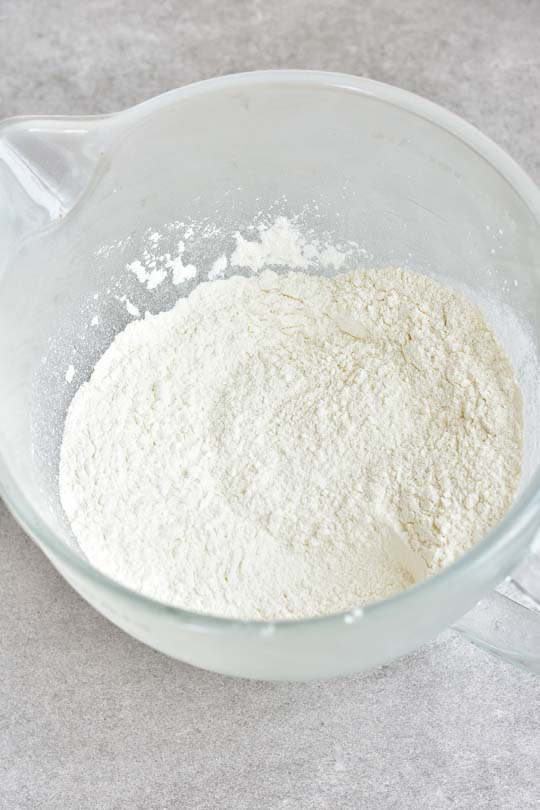
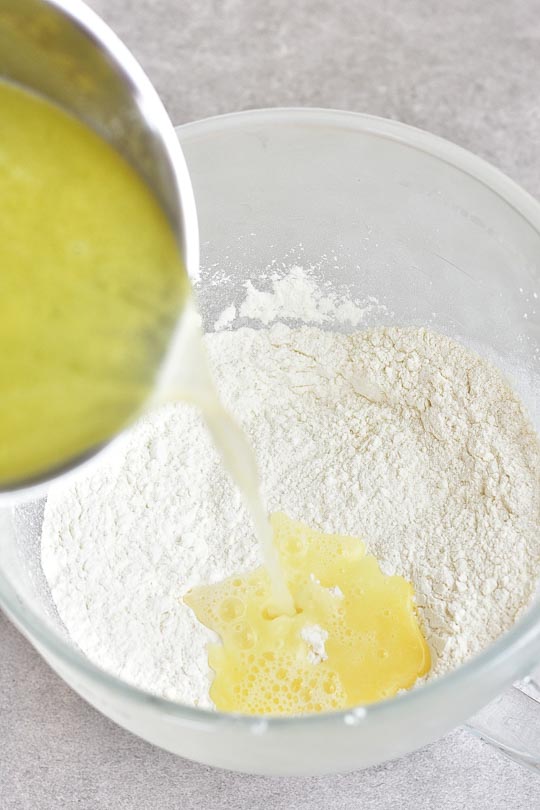


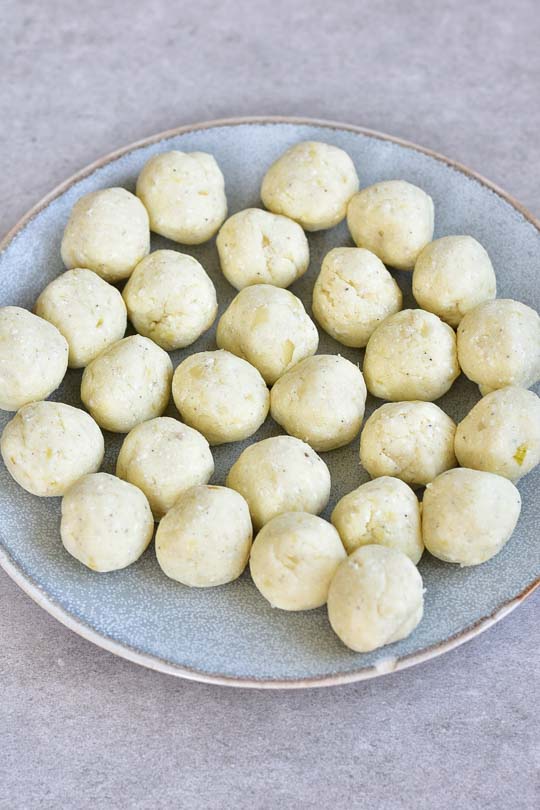
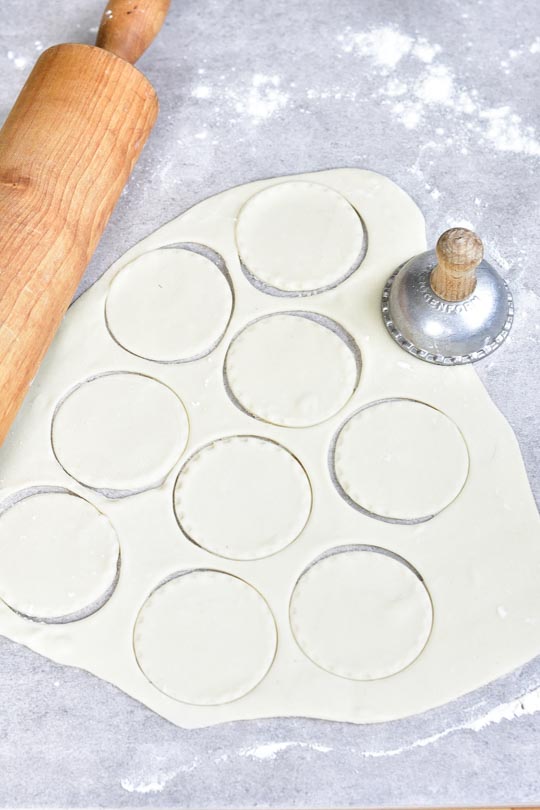
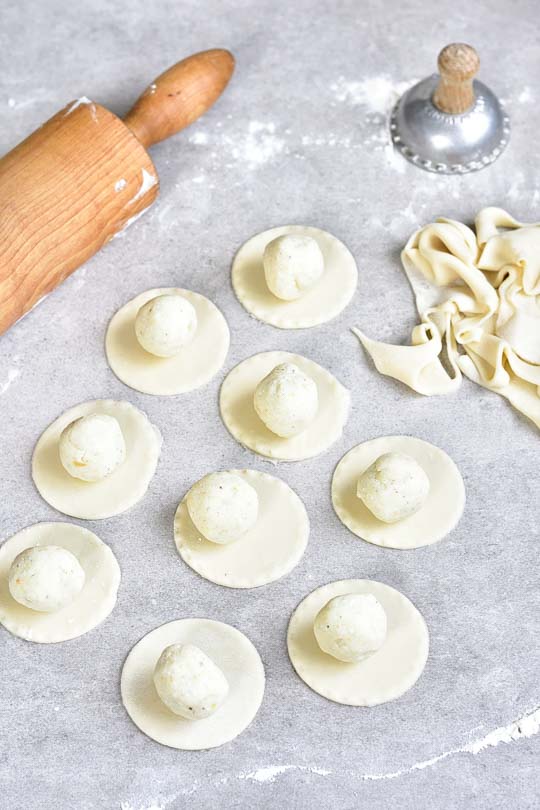
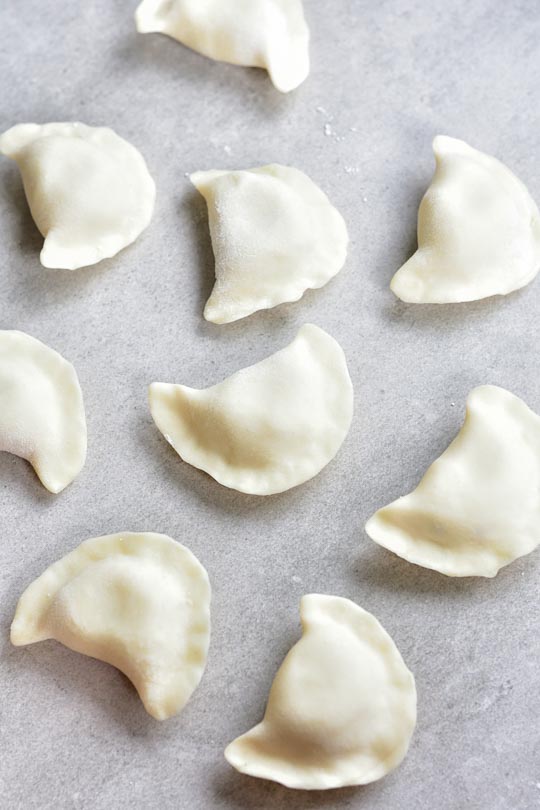
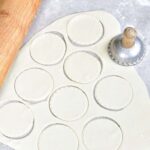
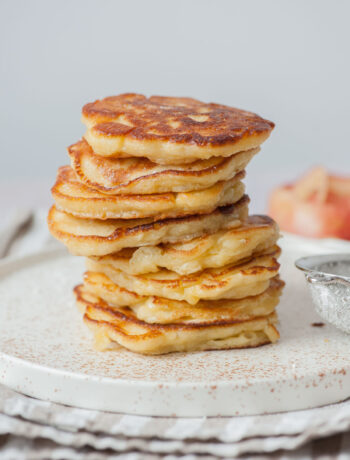
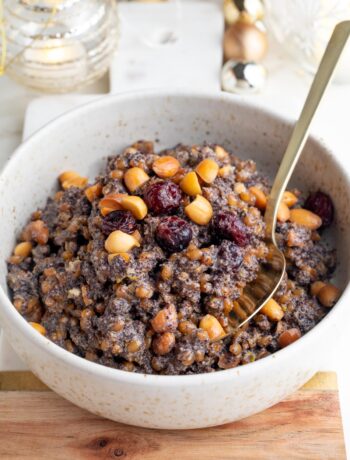
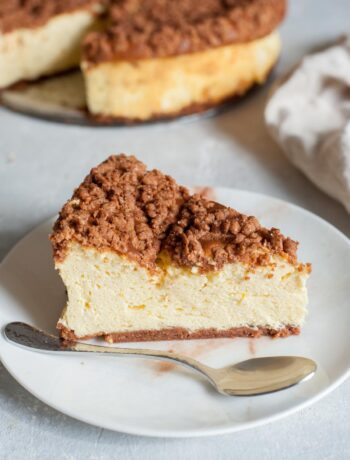
340 Comments
Jackie
30 March 2020 at 00:21I made your dough recipe filled with potato cheddar cheese filling yesterday and it was the best pierogi I ever made. The dough was really easy to work with and I had no problem sealing them closed. Thank you for the great recipe!
Scott
13 March 2020 at 21:43I followed the recipe, dough seams tight to me. but I can’t thank you enough, best pierogi I ever had. they did come out soft.best recipe I ever came across. can not thank you enough
Sharon Baum
9 March 2020 at 18:21Had a group of friends over to make 10 lbs of potatoes. Had to make several batches of pirogie dough, and we used this recipe. The last batch I made, I got distracted, and the water/butter accidentally boiled. I learned boiling is not good. I was using a mixer with the dough attachment for all batches. But this last batch, I had to add about 3/4’s cup more water to make it pliable. Still the dough was tough. The first 3 batches were made according to recipe and the dough was more pliable, but rolling out the dough was an effort. My daughter had a pasta pressor. We had her husband bring it over, and wow, what a difference! It was all so much easier after that. It was effortless and thickness was consistent … even the last ‘tough dough’ batch. We made about 600 pirogies.
Aleksandra
9 March 2020 at 19:44Hi Sharon! Thank you for such a detailed review!
– about the water: you’re right, it should not be boiling, I also learned it the hard way!
– Rolling out of the dough: did you rest the dough for 30 minutes? this could be the reason that the dough was not easy to roll out. If you did rest the dough and it’s it was still not easy to roll out try to sprinkle a lot of flour under the dough and on top of the dough and roll it out, it should help considerably! I also like rolling it out on a silicone mat. I own a Kitchen Aid pasta roller attachment and it was indeed easy to roll out the dough but actually I’ve found rolling it out by hand quicker! I’m glad the recipe has worked for you!
Suzie
16 February 2020 at 13:14Wonderful pierogi dough! So easy to work with! Thank you for sharing.
Aleksandra
16 February 2020 at 13:32happy to hear that! thank you for commenting 🙂
Gerri Page
27 February 2021 at 21:24I made the pirogies but the dough was difficult to roll out and took a lot of effort to seal them. They were nice and soft once put together. What did I do wrong?
Aleksandra
27 February 2021 at 22:02– Did you leave the dough to rest? This is the most common culprit.
– Or maybe you’ve had wrong expectations? This dough is not so easy to roll out like for example cookie dough.
– Another reason could be that you added too much flour – did you weigh your ingredients or used measuring cups? If using cups – how did you fill the cup?
donna
15 February 2020 at 22:38how might this work with cup4cup gluten free flour?
Aleksandra
16 February 2020 at 07:49I’m sorry but I don’t know. I have very little experience with gluten-free flours and haven’t tried making gluten-free pierogi.
Beth
31 March 2020 at 03:28Did you try it? Did it work?
Gary
5 February 2020 at 13:09Nice recipe! My mother was Polish .She used to add a little sour cream to the dough gives it a nice flavor! Try it you might like it!CHEERS!
Aleksandra
5 February 2020 at 16:34thank you, I will! 🙂
Angel
22 January 2020 at 20:28I can’t seem to find the filling recipe!
Aleksandra
23 January 2020 at 01:21Hi! This is just a dough recipe. Above the recipe card, you’ll find links to 6 different filling recipes. You can also type in ‘pierogi’ into the search bar at the top right corner of the site, and there you’ll find all the recipes. Hope this helps!
Aleksandra
22 January 2020 at 12:21Review from a Pinterest reader Kathy: This is THE BEST DOUGH recipe I have ever made! Simple ingredients, easy to roll out! Will never make another and I’ve been making these for 45 years . Thank you!
Laurie
14 January 2020 at 14:29The pierogi recipe was excellent. I followed your recipe except added 1 egg because my Polish grandma always did. She used oil instead of butter. The butter in your recipe was what took these pierogi to the next level.
Aleksandra
14 January 2020 at 19:55Happy that you liked the recipe 🙂
Alison Fox
11 January 2020 at 21:02I never leave comments but this dough is so awesome I had to write. I’m Ukranian/Polish and have used my grandmother’s recipe forever. However it was an egg dough and I always had problems with rolling it out. Even after resting for a good long hour. Now I know it was the egg. Your dough recipe is my new go to. I’m so glad I found this. Sorry Grandma. You’re still the best in heaven!
Aleksandra
11 January 2020 at 21:45thank you! I understand what you mean, both of my Polish grandmas use the egg in the dough. I always loved their pierogi and thought they’re perfect.. until I made my own 🙂 thank you for the comment 🙂
Elaine
24 December 2019 at 00:57OK, I made the pierogies with the Miyokos vegan butter and they came out perfectly!!
Aleksandra
24 December 2019 at 06:33That’s great! Thanks for the feedback 🙂
K
23 December 2019 at 19:04I prepare only the amount of pierogi that we are going to eat on a given day (about 14 per person).
14 per person ?
Aleksandra
23 December 2019 at 19:33yes, I would plan 10-15 pierogi per person (mine are rather small)
Robin Lugosi
22 December 2019 at 12:06I have not tried it yet but am looking forward to it . You have many admirers so it must be good. Thankyou for sharing !
Aleksandra
22 December 2019 at 13:01thank you! please let me know how you liked it 🙂
Elaine
21 December 2019 at 16:01Hi there, my Polish mother made pierogies every Christmas Eve and me and my daughter now make them. My daughter is vegan, and I’m wondering if you have ever used Miyokos vegan butter instead of regular butter in the dough? The vegan butter is made with coconut oil and cashews and tastes exactly like dairy butter. I am just wondering if the fat content of the vegan butter might be different than regular butter and affect the consistency of the dough? Thank you!
Aleksandra
21 December 2019 at 16:34Hi Elaine! I haven’t used it but I’m sure it will be fine. You can also add any vegetable oil.
Diane
21 December 2019 at 14:12Hi Aleksandra! Yesterday was our annual big family pierogi making day. We make ahead and freeze for Christmas day. Where can I purchase the cutter that you use and show in your pictures?? I’m looking everywhere and all I find is biscuit or ravioli cutters. Thanks!
Aleksandra
21 December 2019 at 14:36Hi Diane! I also love this cutter. Unfortunately, I got it from my mother in law. I think it’s like 50 years old. I am sorry that I can’t be more helpful..
Kristen
16 December 2019 at 02:32We received a family friend’s recipe for pierogi and tried it today. The dough didn’t seem just right while making them. We had extra filling so I searched for another recipe. I stumbled across yours and let me tell you. . . AMAZING!! The dough rolled out by hand beautifully. We now have perfect perogies for our Christmas Eve dinner. Thank you so much for the recipe!!
Aleksandra
16 December 2019 at 06:34I’m happy to hear that! 🙂
Martin
7 December 2019 at 01:59I made a lot of pierogi this evening. I played with the thickness (I settled on #4 on my KitchenAid pasta attachment). I played with how to cook them, just sautéed, just boiled, boiled then sautéed. I finally have a texture that I like and I will be serving them at Christmas with homemade sour cream, homemade sauerkraut, and homemade kielbasa. Thanks for an easy recipe that works.
Aleksandra
7 December 2019 at 06:42Thank you Martin, I’m happy that you enjoyed them 🙂
Martin
6 December 2019 at 22:09I am making this now. I am so pleased to find a recipe by weight not volume!
Aleksandra
6 December 2019 at 22:20Well, this is how I cook! 🙂
Candy Fisher
24 November 2019 at 23:09I have been making pierogi for a long time and never felt I had the right dough recipe , until today. Thank you. I think not having egg in the dough and letting it rest for 30 minutes was the secret. I’m a very happy cook !!!!!
Aleksandra
25 November 2019 at 09:18Your comment makes me so happy! Thank you, Candy 🙂
Beth
11 November 2019 at 19:07My pierogi turned out amazing. I was looking for an egg free dough recipe because my grandson is allergic and I actually liked it better without the eggs! This dough is great to work with. Thank you for the recipe
Aleksandra
11 November 2019 at 19:09I’m happy to hear that! thanks for the review 🙂
Gerri Page
23 February 2020 at 00:09I followed the instructions exactly and the dough did not stick to my fingers and I kneaded if for 5 minutes and then put it aside for a half hour. I used the standing mixer. I really had to work at rolling the dough flat. It did not feel soft and pliable and I had to work hard to pinch it together because it wouldn’t. I boiled them and they were tender and delicious but the work effort was too much. What happened?
Aleksandra
23 February 2020 at 07:13Hi Gerri! I’m so sorry to hear that! I’m not sure what happened but I think you haven’t used enough flour to sprinkle the dough when rolling it out. Just sprinkle the dough with flour on both sides until it is easy to roll out. It will help considerably also with sealing the pierogi. I hope this helps!
Jerry
2 March 2020 at 07:39Dampen half of the dough circle with your finger dipped in water then pinch together. Good luck.
Arthuro
31 March 2020 at 05:22Made this in my Kitchen Aid, followed recipe in volume. Let machine work dough for 10 minutes. Let it rest almost 45 minutes. It was still warm and so silky! Divided in four and ran through pasta maker on 1, then 2. Cut sheet in half and ran to 4. Thank you!